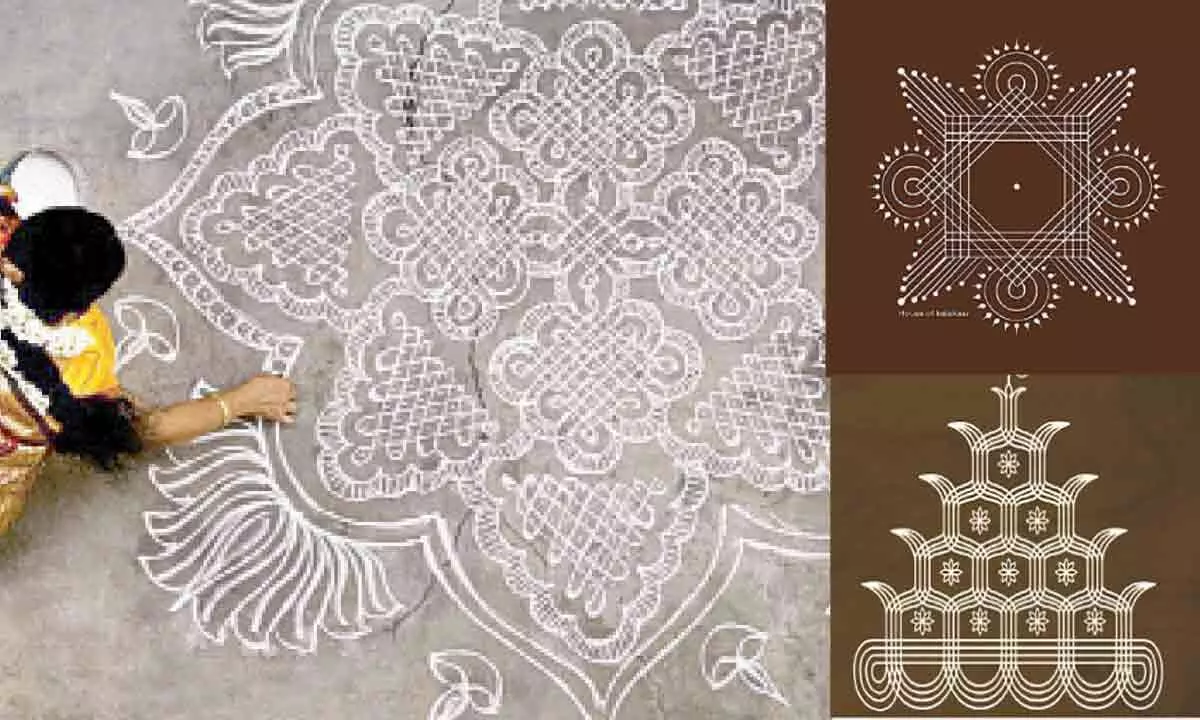Rangoli: Kolams to Chowks, showcasing its regional expressions

Dr. Harsha Bhargavi Pandiri, Assistant Director, Information & Public Relations Department, Government of Telanganac
Rangoli, an art form deeply embedded tradition, an expression of devotion, and a silent storyteller. It is a traditional Bharat decoration, is created using the thumb and forefinger, Rangoli designs are filled with colors to auspicious welcome guests and various Gods and Goddesses, celebration of occasions, expression of creativity, connection with community, and passing down traditions.
Lopamudra, the wife of Augustya Rishi, was inspired by the Panchatatva to create rangoli for her husband’s worship of the gods. She collected blue from the sky, green from water, black from soil, red from fire, and white from wind, which she added to the rangoli made from ground rice, lentils, flowers, and spices.
The colours in Rangoli bring elements that we wish for in the new year when celebrating Diwali. There are two types of Rangoli: dry Rangoli introduced by Lopamudra and wet Rangoli introduced from Sita Ma. The dry Rangoli, created by Lopamudra, represents calm and imagination, while black brings strength and stability. Red symbolizes the code of conduct, and white represents peace and positivity.
Rangoli is believed to welcome deities and bring good luck, and its vibrant colors and intricate designs are seen as an invitation to prosperity and happiness. It also serves as a bridge between generations, with mothers teaching their daughters and grandmothers guiding their granddaughters. Rangoli’s beauty lies in its adaptability, taking on unique forms and meanings across different communities in India.
Rangoli has different origins and uses across India, with stories surrounding its origin and use. In Gujrat, Lord Krishna settled in Dwarka, and his wife Rukmani started the rangoli pattern. In Gujarat, Rangoli is called Satiya, as Krishna is the Satiya (partner) of Rukmani. Other names for Rangoli include Alpana in West Bengal, Joti in Orissa, Chouk Purna in Chattisgarh, Rangoli in Karnataka, Sanskara Bharati in Maharastra, and Kolam in Tamil Nadu. Despite its diverse cultures, customs, and names, Rangoli remains a common symbol of joy and prosperity in India.
In Tamil Nadu, ‘kolam’ is a daily ritual drawn with rice flour to ward off evil, while in Kerala, ‘pookkalam’ uses colorful flower petals for floral designs. In Rajasthan, ‘chowk’ features bold geometric patterns, while in Punjab, ‘rangoli’ is often adorned with colorful diyas. In West Bengal, ‘alpana’ uses rice paste for intricate designs, and in Odisha, ‘chita’ features intricate patterns made with colored sand. Despite changing times, rangoli continues to thrive, finding expression on floors, canvas, walls, and clothes.
Rangoli, a vibrant art form in western India, is a living tradition that is constantly evolving. In Gujarat, it is known as Chowk, with geometric patterns and shapes. In Rajasthan, it is called Mandana, with bold geometric patterns and vibrant colors. In Maharashtra, it is called Rangwali, with floral patterns and geometric shapes. In Eastern parts of Bharat, it is called Alpana, with intricate designs and colors with geometric designs and influence from tribal art heritage. Rangoli is also a symbol of religious significance, storytelling, and community bonding.
Rangoli, a traditional Indian art form, is deeply rooted in various regions. In Tamil Nadu, it is an everyday ritual where women draw intricate rice flour patterns outside their homes, symbolizing prosperity and warding off negativity. In Kerala, it is an integral part of the Onam festival, featuring large floral arrangements with symbolic meanings. In Andhra Pradesh and Telangana, it is a daily ritual with auspicious motifs.
Nandalal Bose, an Indian artist and educator, advocated for the traditional art form of alpona, a vital part of Bengali culture. Influenced by Tagore’s philosophy, Bose taught at Visva-Bharati University, included alpona in his curriculum, and encouraged its practice. Today, alpona remains a popular Bengali art form, a universal language for all cultures.
The art form is passed down through generations, with modern artists experimenting with new materials and incorporating contemporary themes. In Northern part of Bharat, Rangoli is deeply woven into everyday life, with designs adorning doorways and courtyards during festivals. The art is passed down through generations, with generations sharing knowledge and techniques. Modern artists are experimenting with new materials and incorporating contemporary themes, ensuring the art form remains relevant and inspiring young minds.
Tribal India’s Rangoli is a vibrant tapestry that transcends its decorative role, becoming a sacred language whispered in pigments and patterns. Rangoli is a canvas of nature’s bounty, embracing natural materials like leaves, petals, twigs, pebbles, and animal bones. These designs are not just about aesthetics but also a coded language speaking of myths, legends, and ancestral wisdom. They are temporary, drawn with readily available materials, echoes the cyclical nature of life and the transient beauty of the natural world.
Tribal Rangoli plays a key role in rituals and ceremonies, connecting communities to their deities and ancestors. They are also used in sacred spaces, acting as a bridge between the past and present, and preserving tribal traditions. Some tribal communities are incorporating recycled materials, modern color palettes, and contemporary themes into their Rangoli designs.
The contemporary designs on costumes and accessories are mostly inspired from the rangoli from various parts of the country.


















